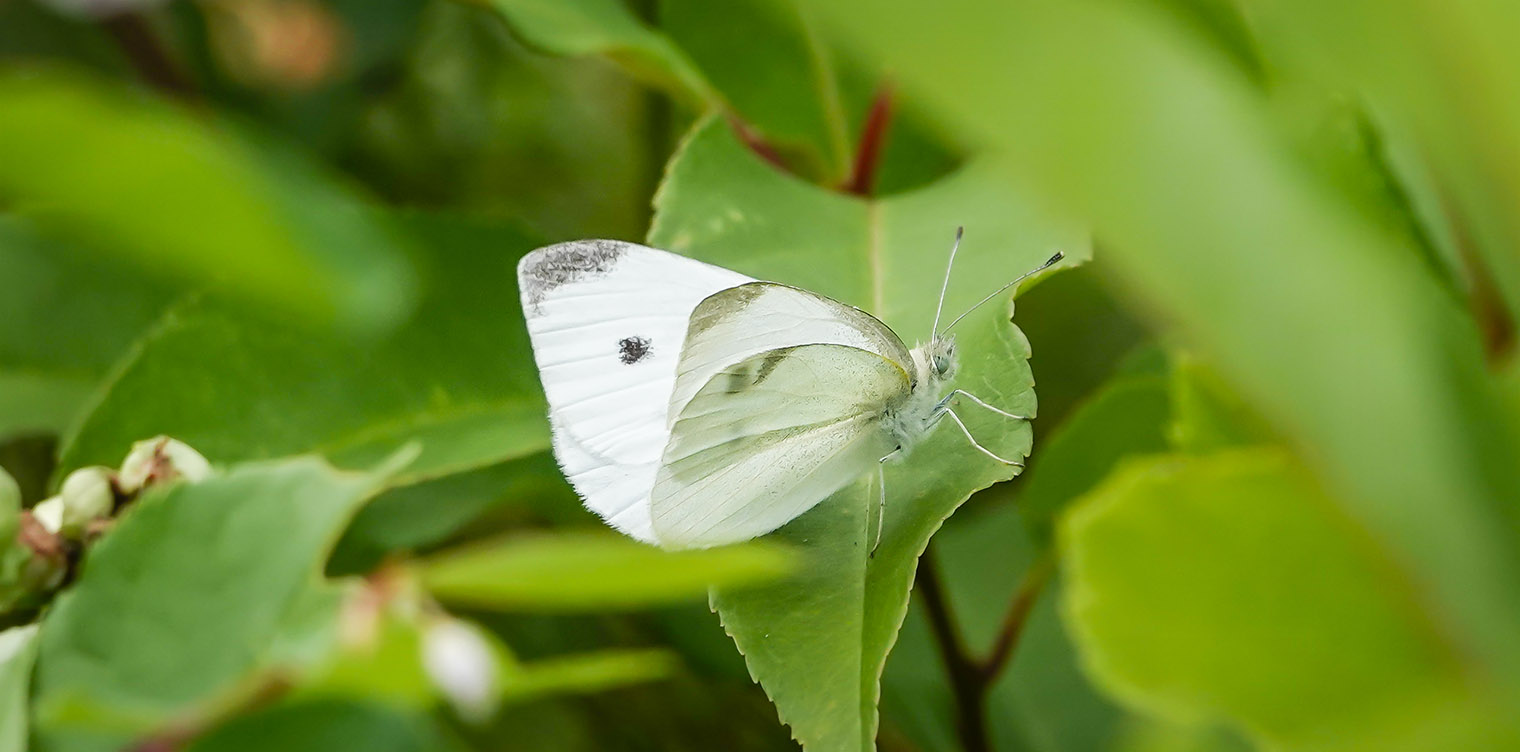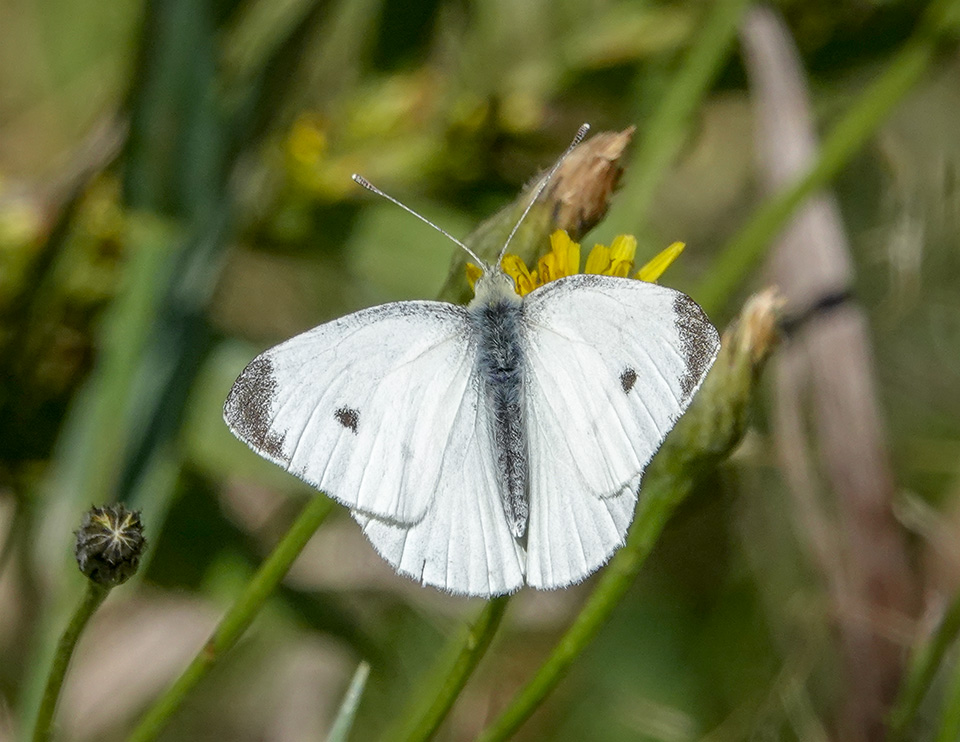Butterflies of the Adirondacks:
Cabbage White (Pieris rapae)

The Cabbage White (Pieris rapae) is a small to medium-sized whitish butterfly [1] which may be seen in the Adirondack Mountains of upstate New York in summer and early fall.
This butterfly is also known as the Small White and European Cabbage. The latter name is apparently a reference to the fact that this insect (reportedly native to Eurasia and North Africa) [2] was accidentally introduced to North America from Europe. [3] [4] [5] [6] The Cabbage White is said to be the most ubiquitous butterfly in the United States. [7] [8] [9]
Cabbage White: Identification
The Cabbage White is small to medium-sized, with a wingspan of about 1¼ to 1⅞ inches. [10] The upper side of the wings are white or pale yellowish white, with a charcoal to black patch on the fore wing. The female has two submarginal black spots on the upper side of its forewing; the male has one. Cabbage Whites seen in spring and fall, during periods of shorter days, are smaller, less yellow, and have reduced black areas. [11]
Cabbage Whites are most commonly seen from below, since they usually come to rest with their wings closed. From below, both wings are evenly a yellowish green or gray-green. [12] [13]
Cabbage White: Life History

Sources conflict on the character of the Cabbage White's flight. Some state that its flight is strong but erratic,[14] while others contend that the flight of this butterfly is straight and constantly fluttering, with minimal gliding.[15]
Male Cabbage Whites patrol for females around host plants.[16] Females lay single eggs on the undersides of host leaves. The eggs are yellowish green to white and vase-shaped with several vertical ridges. [17]
The caterpillar is up to ¾ inches long. It is bright green with a thin broken yellow line on each side, as well as a thin yellow dorsal line.[18] Caterpillar hosts include many plants in the mustard family. The chrysalis, which is up to ¾ inches long, is speckled green or tan.[19]
Adult Cabbage Whites consume flower nectar from a wide array of plants including mustards, cabbage, cauliflower, dandelion, red clover, asters, and mints. [20] [21] [22]
Cabbage White: Habitat and Range
From the ecological standpoint, the Cabbage White is a generalist. [23] Its habitat includes almost any type of open space, such as bogs, meadows, woods, roadsides, gardens, and suburbs. [24] The range of this butterfly is from central Canada south through the United States to northwest Mexico. [25]
Cabbage White: Flight
Most sources indicate that the flight period for this butterfly is from early spring to the first hard frost in the fall, with two to three broods in the northern parts of its range and more in the south. Naturally, the flight period varies with location. In the New York City area of New York State, Cabbage Whites are seen from late March to hard frost, although they are most numerous from early June through early September. [26] [27] In southern Ontario, Cabbage Whites can be found from mid-April to mid-October. [28] In Massachusetts, Cabbage Whites are seen from early spring to late fall. [29]
The flight period of Cabbage Whites in the Adirondack Park is not known, but appears to be much shorter and focused on summer through early fall.
- Cabbage Whites were seen in the Paul Smiths VIC Native Species Butterfly House and in the adjacent Butterfly Garden throughout most of the summer of 2012. We had Cabbage Whites in the Butterfly House almost every day that the house was open, except for the first week and one other week.[30] In subsequent years, Cabbage Whites were present in the Butterfly House from early July through the middle of August.[31]
- In 2018, there were confirmed sightings of Cabbage Whites in the Adirondack Park on the Butterflies and Moths of North America site from late June to mid-October. In 2019, there were fewer confirmed sightings, from late July and August. [32]
- Evidence from iNaturalist also suggests the Cabbage Whites are most abundant in the Adirondack Mountains from mid-summer through early fall. In 2016, there were only a few Cabbage White observations reported on iNaturalist, in late August and early September. [33] There were no Cabbage White observations reported in 2017. [34] In 2018, there were iNaturalist observations of Cabbage Whites in July, early August, and early October. [35] In 2019, most of the iNaturalist observations in the Adirondack region were clustered in late July through early September. [36] In 2020, most of the Cabbage Whites observed in the Adirondack region were seen in July and August. [37]
References
- Susan Grimm Hanley. Interpretive Naturalist, Paul Smith's College Native Species Butterfly House. Species Logbooks.
- Butterflies and Moths of North America. Species Profiles. Sighting records: 6/16/2012; 6/16/2012; 7/25/2012; 8/8/2012; 9/1/2012; 9/9/2012; 7/6/2013; 7/6/2013; 7/5/2014; 7/19/2014; 8/19/2014; 6/20/2018; 6/30/2018; 7/7/2018; 7/7/2018; 7/21/2018; 7/23/2018; 8/11/2018; 8/19/2018; 8/20/2018; 8/23/2018; 8/27/2018; 8/30/2018; 9/13/2018; 9/13/2018; 9/16/2018; 9/24/2018; 9/24/2018; 9/24/2018; 10/10/2018; 7/23/2019; 8/19/2019; 8/30/2019. Retrieved 1 September 2019.
- iNaturalist. Adirondack Park Sightings 2016. Cabbage White. Retrieved 18 September 2021.
- iNaturalist. Adirondack Park Sightings 2017. Cabbage White.Retrieved 18 September 2021.
- iNaturalist. Adirondack Park Sightings 2018. Cabbage White. Retrieved 18 September 2021.
- iNaturalist. Adirondack Park Sightings 2019. Cabbage White. Retrieved 18 September 2021.
- iNaturalist. Adirondack Park Sightings 2020. Cabbage White. Retrieved 18 September 2021.
- Government of Canada. Canadian Biodiversity Information Facility. Species Bank. Cabbage White. Retrieved 1 September 2019.
- Massachusetts Butterfly Club. Massachusetts Butterfly Species List. Retrieved 1 September 2019.
- Massachusetts Audubon. Butterfly Atlas Species Accounts. Cabbage White. Retrieved 1 September 2019.
- Iowa State University. Department of Entomology. BugGuide. Pieris rapae. Retrieved 1 September 2019.
- Ross A. Layberry, Peter W. Hall, and J. Donald Lafontaine. The Butterflies of Canada (University of Toronto Press, 1998), p. 87, Plates 7, 22, and 26.
- National Audubon Society. Field Guide to Butterflies (New York: Alfred A. Knopf, 1981), pp. 360-361.
- Jim P. Brock and Kenn Kaufman. Kaufman Field Guide to Butterflies of North America (Houghton Mifflin, 2003), pp.46-47.
- Paul A. Opler. A Field Guide to Eastern Butterflies (The Peterson Field Guide Series, Houghton Mifflin Company, 1992,1998), pp. 46-47, 50-51, 56-57, 149.
- Jeffrey Glassberg. Butterflies of North America (Michael Friedman Publishing, 2002), pp. 70-71.
- James A. Scott. The Butterflies of North America. A Natural History and Field Guide (Stanford University Press, 1986), p. 216-217.
- Donald and Lillian Stokes. Stokes Butterfly Book. The Complete Guide to Butterfly Gardening, Identification, and Behavior (Little, Brown and Company, 1991), pp. 50-53.
- Jeffrey Glassberg. Butterflies through Binoculars. The East. A Field Guide to the Butterflies of Eastern North America (Oxford University Press, 1999), p. 54, Plate 6.
- Paul A. Opler and George O. Krizek. Butterflies East of the Great Plains: An Illustrated Natural History (The Johns Hopkins University Press, 1984), pp. 59-60.
- Rick Cech and Guy Tudor. Butterflies of the East Coast. An Observer's Guide (Princeton University Press, 2005), p. 77.
- Jeffrey Glassberg. Butterflies through Binoculars. A Field Guide to the Butterflies in the Boston-New York-Washington Region (Oxford University Press, 1993), pp. 28-29, Plates 4 and 5.
